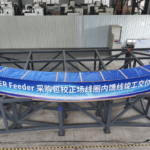This year marks the final stretch of the 14th Five-Year Plan (2021-2025), with a strong emphasis on developing new quality productive forces. Introduced in 2023, this concept signifies advanced productivity liberated from traditional economic growth models, focusing on high-tech, high efficiency, and high quality. Key areas include artificial intelligence, big data, and new materials.
Rising R&D Fuels Innovation 🔬
China has solidified its position as a global innovation leader, climbing to 11th place in the Global Innovation Index last year. This ranking reflects one of the fastest improvements among major economies over the past decade. Sustained investments in research and development (R&D) have been pivotal, with R&D expenditure reaching 2.68 percent of GDP in 2024—a 0.1 percentage point increase from the previous year. Basic research funding surged by 10.5 percent, now making up 6.91 percent of total R&D spending, according to the National Bureau of Statistics (NBS).
Total R&D spending in China surpassed 3.6 trillion yuan (approximately $500 billion) last year, marking an 8.3-percent increase compared to the previous year. Zhang Qilong, an NBS statistician, highlighted that favorable policies, a diversified investment environment, and stronger business involvement have significantly contributed to the consistent growth in R&D spending. With an R&D intensity of 2.68 percent, China ranks 12th among major countries, surpassing the European Union's average of 2.11 percent and nearing the OECD's figure of 2.73 percent.
New and Old Industries Embrace Tech 🌐
China's industrial landscape is undergoing a transformative shift as emerging sectors rapidly expand. Kang Yi, commissioner of the NBS, reported that the value-added output in high-tech manufacturing above designated size grew by 8.9 percent year-on-year in 2024. Notably, the aerospace equipment and electronic communication device manufacturing sectors posted double-digit growth, while smart consumer equipment manufacturing surged by 10.9 percent. This growth is driven by soaring demand for intelligent car-mounted devices (up 25.1 percent) and unmanned aerial vehicles (up 53.5 percent).
\"New market demands are accelerating the supply of high-quality products, reshaping China's industrial pillars,\" Kang emphasized.
Legacy industries also saw robust modernization efforts in 2024. Technical transformation investments in manufacturing rose by 8 percent, outpacing overall investment growth. Meanwhile, the digital economy continued its rapid ascent. The value-added output in digital product manufacturing exceeded industrial averages, and the information transmission, software, and IT service sector expanded by 10.9 percent.
Digital consumption innovations further spurred online retail sales of physical goods, which climbed by 6.5 percent. Infrastructure for next-gen connectivity advanced steadily. By November 2024, China had deployed 4.19 million 5G base stations and launched its first 400G all-optical interprovincial backbone network under the \"East Data West Computing\" project, establishing ultra-high-speed computing channels.
Reference(s):
cgtn.com





